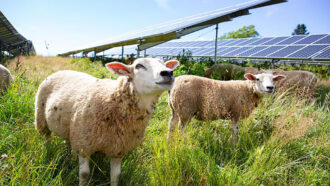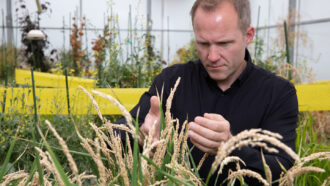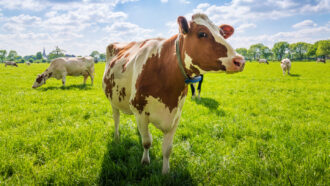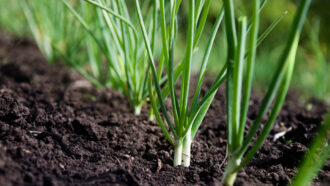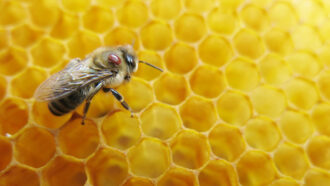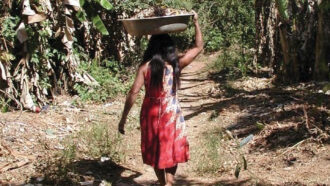Your food choices affect Earth’s climate
Eating meat can have twice the ‘carbon footprint’ of consuming fruits, veggies and grains

By Janet Raloff
Every action has a cost. That’s as true for driving a car as it is for growing food and delivering it to your dinner plate. A team of researchers has just tallied the costs of producing meat versus other types of foods for human diners. They find that meat production — from farm to fork — releases more climate-warming pollution that does producing fruits, vegetables, nuts and grains. A lot more.
Their calculations suggest that people could do a lot to slow global warming if they limited how much meat they eat.
There are plenty of “costs” to producing any goods, including food. Sure, people pay money for the food as well as the fuel needed to get groceries to the store or restaurant. But those are just the most visible costs. Producing things also takes resources. For foods, this includes the water used to irrigate crop fields. It also includes the fertilizer and chemicals that boost plant growth and fight pests. And don’t forget the gasoline and diesel that fuel plows and also those trucks that take crops to market.
Along with those resources are wastes: pollution. Manure is one obvious pollutant associated with meat production. But there are others, including the air pollutants spewed by tractors that plow fields and the trucks that move feed to the animals and animals to the slaughterhouse. Peter Scarborough at the University of Oxford in England, and his colleagues decided to tally some of the less-visible pollution created by food production.
They focused on greenhouse gases. In the atmosphere, these gases trap heat from sunlight. Lately they’ve been trapping too much, causing a sort of mild, global fever. Overall, food production accounts for one-fifth of this type of pollution.
One greenhouse gas emitted through the production of our food is carbon dioxide, or CO2. It’s released by the burning of fossil fuels, such as gasoline and natural gas. They are used to power farm machinery, to take foods to market (and home), to store foods awaiting processing and to cook foods. The researchers also tallied methane. Fermentation in the guts of ruminant livestock — mostly cows — releases this gas. And the scientists calculated the nitrous oxide released during the plowing and fertilizing of crop fields.
All three gases are important. CO2 is the greenhouse gas released in the highest volume. But methane and nitrous oxide stay in the atmosphere far longer than CO2 does. As such, they are more potent, molecule for molecule, in warming Earth’s atmosphere.
A computer converted the methane and nitrous-oxide emissions for each person’s diet into its carbon-dioxide “equivalent.” That’s the amount of CO2 needed to warm Earth’s atmosphere by the same amount as the methane or nitrous oxide would.
Switching from meat-rich meals to vegetarian ones would reduce the average meat eater’s CO2 equivalents — also known as its carbon footprint — by 1,230 kilograms (about 1.4 U.S. tons) per year, the new study calculated. Scarborough’s team presented its findings in the July issue of Climatic Change.
How they calculated food’s ‘carbon footprint’
In the 1990s, a survey asked 65,000 adults what they typically had eaten throughout the past year. Scarborough’s team fed those data into a computer. The researchers also included the amount of greenhouse gases linked with producing nearly 100 common foods. Then the computer matched those greenhouse-gas amounts to the mix of foods each person had reported eating.
Some people had eaten lots of meat. Others hadn’t. Some had been big fish eaters. Others weren’t. All people ate some plant-based foods, such as salads, grains, bread, beans or fruit. Some reported being vegetarians. That means they downed only plant-based foods with the exceptions of possibly eggs, fish or milk. Others, vegans, reported eating no meat, poultry, fish or dairy foods (including cheese, butter and yogurt).
The diet of someone whose meals included an average of 50 to 99 grams (1.8 to 3.5 ounces) of meat each day would be responsible for the daily release of 5.6 kilograms (12.4 pounds) of CO2 equivalents, according to the new analysis.
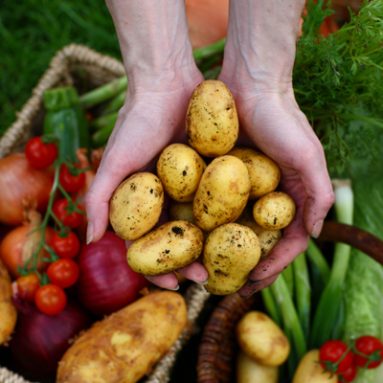
Scientists don’t expect many people will give up eating meat entirely. In fact, in England the trend has been in the opposite direction. The share of people there who consider themselves vegetarians or vegans fell from 5 percent in 2000 to just 2 percent by 2010. Over the same period, meat consumption climbed 7.8 percent — to 84.2 kg (186 lbs) per person.
U.S. data show that as of 2012, 4 percent of men and 7 percent of women considered themselves vegetarians. However, Americans continue to consume more meat than people in the United Kingdom and Europe. Each year the average American adult downs about 120 kg (265.7 lbs) of meat.
Still, the new study “demonstrates that reducing the intake of meat and other animal-based products can make a valuable contribution to climate change mitigation,” its authors conclude. And there’s another advantage to reducing meat consumption, the researchers point out. Compared to meat, more plant-based food calories can be grown on a plot of land — and with less water and other resources. In places where many people are going hungry, as they are in large parts of the world, raising meat may make it harder to ensure that everyone gets enough to eat.
Beyond greenhouse gases
“I think it’s interesting,” Danielle Nierenberg said of the new study. She’s president of Food Tank, a food-policy organization based in Washington, D.C. Looking at greenhouse gases is important, she says. But, she adds, it’s just one of many environmental costs of foods.
“The more we think about what we’re eating, and food’s role in sustainability or in climate change, that’s a good thing,” she says. But, she adds, “more needs to be done to be sure that
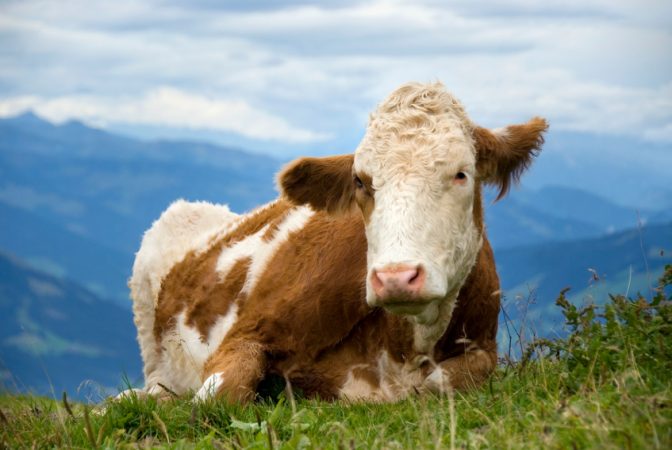
we’re capturing everything.” By that she means scientists want to be sure that they are not missing important environmental “costs” of producing food.
Those costs may have to do with the resources. Some crops are water hogs, which can be a problem in areas with little rain. Others may require a lot of processing — using water and plenty of expensive energy — to clean, cook-up, package or deliver foods to grocery shoppers.
And then there are a range of less visible environmental problems. Animals may harden the soils, making the land less likely to soak up water when it rains. Often farmers rely on weed killers and pest killers to improve the size of their crop harvests. Many of those chemicals can be toxic to wildlife and people. Some fertilizers can pollute groundwater. Plowing fields can lead to erosion. That can diminish the fertility of soils.
Finally, Nierenberg notes, even for meat, “not all meat is created equal.” Some farmers pen cattle in feedlots to fatten them quickly. This requires feeding them an unnatural diet and releases a lot of animal wastes (poop and pee) into a small area. In contrast, some farmers graze their cattle on pastures. Allowing the animals to eat grass and over a broad expanse of land helps ensure that the soil is protected and that native plants are not trampled to death.
There can also be a similar range of environmental differences in the way plant-based foods are farmed. Some can be less wasteful and less polluting than others.
Scarborough’s team took a good first step in tallying costs, Nierenberg says. But, she argues, more details will be needed about how foods are grown to truly know which foods — or farm practices — take the biggest toll on Earth’s total environment.
Power Words
atmosphere The envelope of gases surrounding Earth or another planet.
carbon dioxide (abbrev. CO2) A gas produced by all animals when the oxygen they inhale reacts with the carbon-rich foods that they’ve eaten. This colorless, odorless gas also is released when organic matter (including fossil fuels like oil or gas) is burned. Carbon dioxide acts as a greenhouse gas, trapping heat in Earth’s atmosphere. Plants convert carbon dioxide into oxygen during photosynthesis, the process they use to make their own food.
carbon dioxide equivalents In the atmosphere, carbon dioxide (CO2) works as a heat-trapping gas — often called a greenhouse gas. Many other gases — such as methane and nitrous oxide and hydrofluorocarbons — also trap heat, but their lifetime in the atmosphere can be far longer than carbon dioxide’s. So to compare the warming potential associated with those other pollutants, scientists often convert them into what they term CO2 equivalents. That’s the amount of CO2 needed to warm Earth’s atmosphere by the same amount as those longer-lasting warmers would.
carbon footprint A popular term for measuring the global warming potential of various products or processes. Their carbon footprint translates to the amount of some greenhouse gas — usually carbon dioxide — that something releases per unit of time or per quantity of product.
climate The weather conditions prevailing in an area in general or over a long period.
ecosystem A group of interacting living organisms — including microorganisms, plants and animals — and their physical environment within a particular climate. Examples include tropical reefs, rainforests, alpine meadows and polar tundra.
fermentation The metabolic process of converting carbohydrates (sugars and starches) into short-chain fatty acids, gases or alcohol. Yeast and bacteria are central to the process of fermentation. Fermentation is a process used to liberate nutrients from food in the human gut. It also is an underlying process used to make alcoholic beverages, from wine and beer to stronger spirits.
fertilizer Nitrogen and other plant nutrients added to soil, water or foliage to boost crop growth or to replenish nutrients that removed earlier by plant roots or leaves.
fossil fuels Any fuel (such as coal, oil or natural gas) that has developed in the Earth over millions of years from the decayed remains of bacteria, plant or animals.
greenhouse gas A gas that contributes to the greenhouse effect by absorbing heat. Carbon dioxide is one example of a greenhouse gas.
methane A hydrocarbon with the chemical formula CH4 (meaning there are four hydrogen atoms bound to one carbon atom). It’s a natural constituent of what’s known as natural gas. It’s also emitted by decomposing plant material in wetlands and is belched out by cows and other ruminant livestock. From a climate perspective, methane is 20 times more potent than carbon dioxide is in trapping heat in Earth’s atmosphere, making it a very important greenhouse gas.
molecule An electrically neutral group of atoms that represents the smallest possible amount of a chemical compound. Molecules can be made of single types of atoms or of different types. For example, the oxygen in the air is made of two oxygen atoms (O2), but water is made of two hydrogen atoms and one oxygen atom (H2O).
nitrogen oxides Pollutants made up of nitrogen and oxygen that form when fossil fuels are burned. The scientific symbol for these chemicals is NOx (pronounced “knocks”). The principle ones are nitric oxide (NO) and nitrous oxide (NO2).
pollutant A substance that taints something — such as the air, water, our bodies or products. Some pollutants are chemicals, such as pesticides. Others may be radiation, including excess heat or light. Even weeds and other invasive species can be considered a type of biological pollution.
sustainability To use resources in a way that they will continue to be available in the future.
vegan A person who subscribes to a fairly extreme form of vegetarianism. Vegans do not eat animal products of any sort, including meat, milk or eggs. Some vegans also avoid use of animal products in their clothing (such as leather, wool or even silk).
vegetarian A person who does not eat red meat (such as beef, bison or pork), poultry (such as chicken or turkey) or fish. Some vegetarians will drink milk and eat cheese or eggs. Some will eat the flesh of fish only, not mammals or birds. Vegetarians get the vast majority of each day’s calories from plant-based foods.
